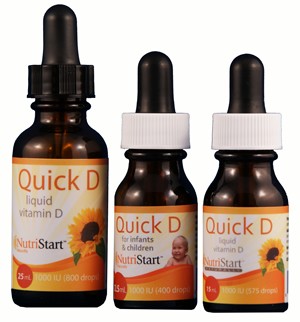Vitamin D Toxicity
Avoiding Vitamin D Overdose
 How much vitamin D is too much? Can you overdose on vitamin D? You will find a far different range of recommendations depending on who you listen to, from the conservative approach of a doctor, through the more up-to-date suggestions of a naturopath, all the way to the enthusiastic over-kill of the true believer.
How much vitamin D is too much? Can you overdose on vitamin D? You will find a far different range of recommendations depending on who you listen to, from the conservative approach of a doctor, through the more up-to-date suggestions of a naturopath, all the way to the enthusiastic over-kill of the true believer.
Vitamin D is Fat-soluble
It is important to note that vitamin D is fat-soluble, which means your body has a hard time getting rid of it if you take too much. As one who is only a nutritional consultant and health researcher, and not a health professional, I never recommend that people take more than 3,000 to 5,000 IU of vitamin D3, on a regular basis, and even then for only 5 days a week. (By skipping a couple of days a week we ensure that if we took too much of a vitamin, the body will have a chance to use it up. Also the body will store the vitamin more efficiently if we do not take it every day.)
I will however suggest that, for certain ailments, one should take 10,000 IU for five days, before dropping to the lower dosage level. But, according to information from vitamin D expert, Dr. Horlick (referred to in the Optimal Blood Levels of Vitamin D blog post), I am definitely erring on the side of caution.
Toxicity of Vitamin D
He was part of a study done in 2002 that showed that you can take up to 10,000 IU of vitamin D a day for up to half a year, and still not reach a level of vitamin D toxicity. In his book he recommends that children can be given up to 2,000 IU daily for their first year of life. For children aged 1 to 12 years old, he believes that 5,000 IU of vitamin D daily is safe, and teenagers and adults can safely take up to 10,000 IU of vitamin D a day (for up to 6 months),without any worries.
In his book, The Vitamin D Solution, Dr. Horlick states that it is pretty much impossible to get an adequate amount of vitamin D from dietary sources. It can also be difficult to get children and teenagers (not to mention some adults), to take a vitamin D supplement every day.
In this case, vitamin D can be supplemented with one large dose on a weekly, or even monthly, basis, as long as the total dose is equivalent to their daily needs for that period of time. For example, if teenagers and adults need a total of at least 2,000 IU of vitamin D a day, then taking 14,000 IU of vitamin D every week, or 60,000 IU of vitamin D every month has been shown to be effective in maintaining the blood levels of 25-hydroxyvitamin D above 30 ng/mL.
I would suggest that these high levels are somewhat debatable, as he is overlooking the necessary co-factors that vitamin D requires, when taken in supplemental form. But, nonetheless, this does show that a world-renown expert in the subject of vitamin D, is confident that we can supplement with relatively high doses, quite safely.
Co-Factors of Vitamin D
The necessary co-factors for vitamin D are vitamins A and K2. It is now believed by some experts that vitamin D toxicity may be due to a lack of vitamin A. (And the inverse probably holds true as well: that vitamin A toxicity comes from taking high levels of vitamin A without adequate vitamin D intake.) This makes sense because the form of vitamin D that we get form supplements is “active”, and the form that we get from the sun is “inactive.” Vitamin D from the sun is stored in the skin and liver until the body activates it, based on its perceived daily needs.
When we eat vitamin D in the active form, from foods, it is most commonly found in liver (fish and mammals), where it is occurs in combination with vitamin A. Where vitamin A creates compounds in the body that break down bone (osteoclasts), vitamin D creates compounds that reform bones (osteoblasts). Together they maintain the health and density of the skeletal structure.
Vitamin D and Hypercalcemia
Excessive vitamin D will also pull too much calcium into the blood stream, ultimately leading to a disease called hypercalcemia, which can cause calcium deposits in the joints, and calcification of the arteries. Other symptoms of hypercalcemia include muscle weakness, joint pain, confusion, loss of appetite, lethargy and fatigue.
When there is too much calcium in the blood, it is up to vitamin K2 to move it back into the skeletal structure. From this we can see that we need to look at vitamin D supplementation as part of a triune that includes vitamins A and K2. By ensuring that we have adequate amounts of vitamins A and K2, we can safely take the higher doses of vitamin D. (For information on dosage levels of vitamin A and vitamin K2, see previous blogs)
The Vitamin D Council and Vitamin D Toxicity
According to on-line experts on vitamin D research, The Vitamin D Council, vitamin D toxicity usually occurs if you take 40,000 IU per day for a couple of months or longer, or take an extremely large one-time dose.
They are much more conservative when it comes to dosing children with vitamin D, clearly more cautious than the recommendations of Dr. Horlick (as stated at the beginning of this article). And in the case of children it is always better to err on the side of caution, unless you are under the guidance of a health professional. If I were to follow the guidelines of Dr. Horlick rather than those below, from the Vitamin D Council, I would ensure that they were also getting some vitamin A and K2.
Vitamin D Dosage for Children
Here are their cautions for dosing children:
-children that weigh 25 lbs or less: 2,000 IU/day for over three months is potentially toxic.
-children that weigh between 25 and 50 lbs: 4,000 IU/day for over 3 months is potentially toxic.
-children that weigh between 50 and 75 lbs: 6,000 IU/day for over 3 months is potentially toxic.
-children that weigh between 75 lbs and 100 lbs, 8,000 IU/day for over 3 months is potentially toxic.
If one wants to try higher levels on children, especially due to some ailment that it might help, remember that you can use higher dosage levels for a short period of time (like one week), and then be sure to skip 2 or 3 days a week as insurance against overdosing.
Optimal Blood Levels of Vitamin D
The ideal blood level of vitamin D that The Vitamin D Council recommends is 50 ng/ml; pretty much the same level as recommended by Dr. Horlick. The Vitamin D Council recommends that adults take 5,000 IU/day of a vitamin D supplement, in order to maintain this level. They also point out that if your blood level of vitamin D is greater than 150 ng/ml, it is dangerously high and possibly toxic. (Link)
In the next blog on vitamin D I will look at how and where to get a vitamin D test, something that is important to do if you are in poor health, or wish to continually supplement with doses of vitamin D higher than 2-3,000 IU per day.
More information
For more information on Vitamin D see our blog posts:
Optimal Blood Levels of Vitamin D
Do We Need Vitamin D in the Summer?
Critical Nutrients for the 21ST Century. Part 1
NutriStart Quick D
 Quick D is made with some of the safest, most stable and natural ingredients available.
Quick D is made with some of the safest, most stable and natural ingredients available.
- Vitamin D3 – Cholecalciferol – the biologically active form from natural sources
- Emulsified liquid form is the most absorbable type of D3
- No unpleasant taste or capsules to take
- Glass bottle and dropper
- Convenient and easy to take
- Organic sunflower oil – a stable and healthy natural base
- Cost effective – with over 960 drops in each bottle, its one of the most economical options on the market.
- Vegetarian friendly
View NutriStart Quick D Vitamin D3